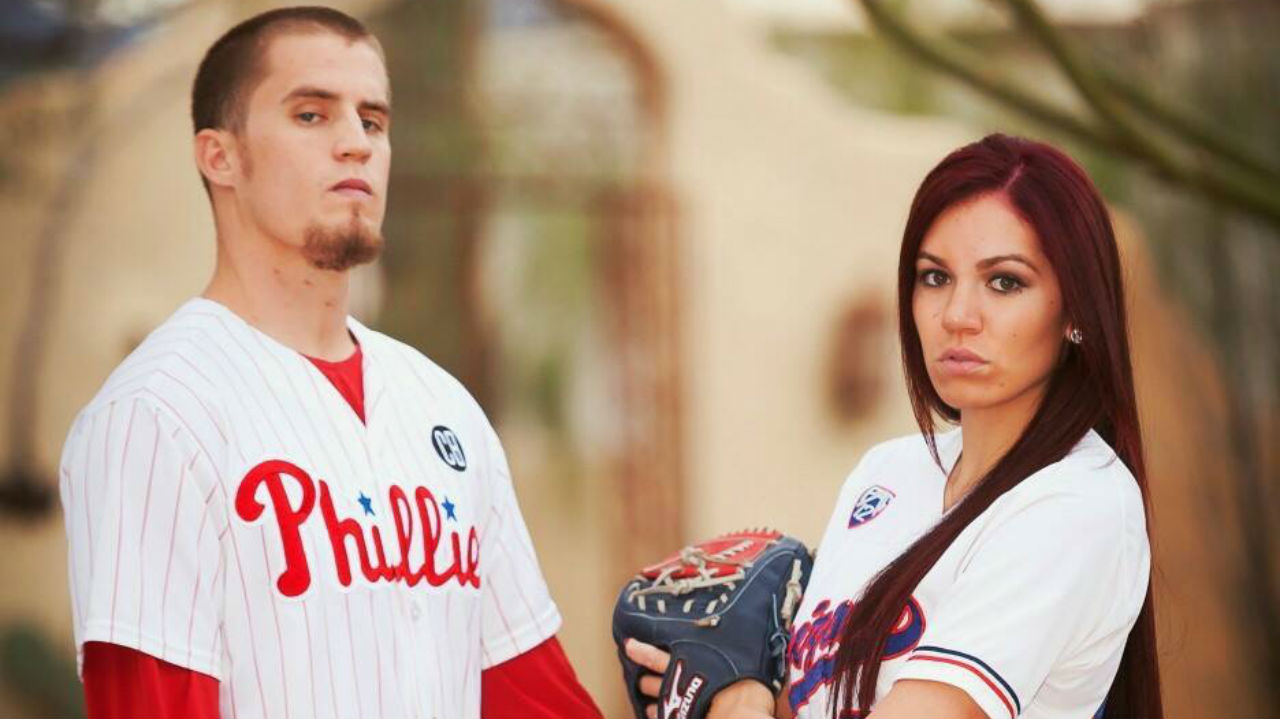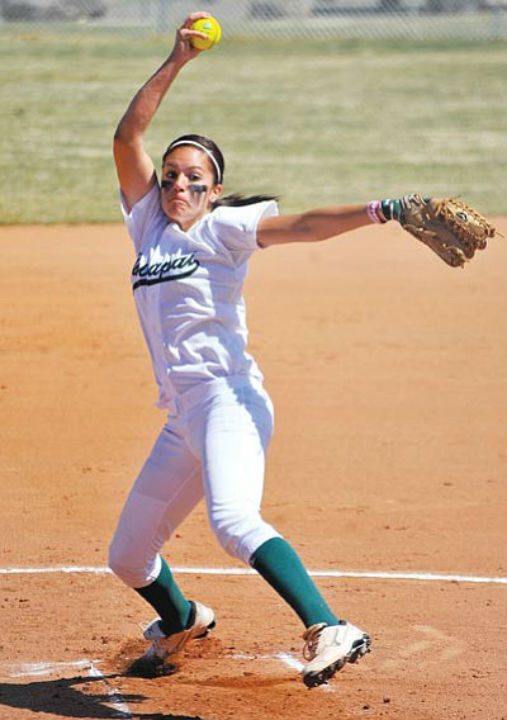TORONTO – Approaching four years of marriage, with one child here and another due soon, Ken and Estela Giles have put their relationship through countless stress tests, continuing unbowed each time. There is, however, one final frontier the current Toronto Blue Jays closer and the former softball pitching star have yet to cross – standing in at the plate against one another.
So, happy couple, who’d rule the day?
“I’d have no chance against her – I’ll admit that,” Ken says sheepishly, only to get none of the same credit back in return.
“I think I can hit the fastball. Just don’t throw me a breaking ball,” says Stela, as she commonly goes by. “But I think I can square one.”
Given that Ken boasts an average velocity of 97.60 m.p.h. this season, plus a whiff percentage of nearly 16 per cent, that’s a pretty bold claim.
“One of these years we might put it to the test,” he says, grinning.
“It’s too early in the marriage to do that right now,” replies Stela.
The light-hearted barbs, exchanged as the uniquely pitching-oriented couple share a couch in their stylish downtown Toronto condo, underline how deep the competitiveness runs in both of them. They’ve known each other since first crossing paths at Yavapai Junior College in Prescott, Arizona, he en route to a pro career that started when the Philadelphia Phillies made him a seventh-round pick in 2011, her en route to the University of Arizona and the Chicago Bandits of the National Pro Fastpitch League.
They quickly became friends, then they became more, sharing a type of understanding no one else could offer. Not only did they have the same role on their respective pitching staff, they’re also very similar with the ball in their hand, each seeking to effectively channel a fierce churn of emotion within. They got that about the other, leading to a bond that’s underpinned their performance on the field as well as their lives off it.
“We’re both very hard on ourselves,” says Stela. “When everyone was like, ‘Hey, it’s OK, you’ve got it next game,’ I’d be like, ‘What do you mean next game? I did bad this game.’ And that’s where we were able to relate and talk to each other, in that sense.’”
“We held each other very accountable for our actions on the field,” says Ken. “If something didn’t go well, we know we’re the reason why we didn’t win the game. That’s what frustrates us the most – something that we could have controlled and didn’t control.”
“We knew how to talk to each other when we had a bad game,” says Stela. “Or a good game.”
Still, the pro ball lifestyle can be a relationship shredder, and it took a full commitment to one another for their relationship to survive once their careers pulled them in different directions.
After Ken signed with the Phillies out of the 2011 draft, he was off to rookie ball in Florida, pitching in the Gulf Coast League before advancing to low-A Lakewood and advanced-A Clearwater in 2012.
Stela, meanwhile, won team MVP honours and helped win a national championship in ‘11 at Yavapai and returned there again in ‘12 before joining Arizona, fulfilling a childhood dream to play for the Wildcats. She spent two seasons there before being drafted by the Bandits. During that span they were apart more often than they were together, their seasons running at differing points on the calendar, a couple of time zones also between them.
The secret? “A lot of texting,” Stela laughs.
“The biggest thing was communication,” says Ken. “We had to trust each other. I put all my trust in her and she put it all in me. She’d let me know, ‘I have this and this at this time, practice until then, classes,’ and I’d be the same way, ‘I’m going to the field, I’m going out for BP, I’ll be shagging for an hour or so, and then I’ve got 30, 40 minutes to talk before the game.’ It was tough.’”
“We’d always tell each other as much as we can what we were doing that day,” says Stela. “So in case I don’t text you back, this is the reason why.”

Despite the challenges, they continued to find ways to offer each other support and advice. Typically, Ken’s games came earlier in the day so Stela would be able to sneak a peek at his performances around her day and send some feedback.
“I would basically text him a paragraph like good job, you got this, blah, blah, blah,” she says, “but that was basically what we had to do because we pretty much had no choice.”
For Ken, tracking Stela meant either staying up late or checking boxscores early in the morning.
“I knew if she had a bad game, I’d just tell her, you know what you need to do the next day to be ready and bounce back, go get them tomorrow and then I’d go off to bed,” he says. “That was the best way for me to let her know that I watched, I know how you’re feeling.”
They never felt the push and pull of their conflicting schedules more than in June 2014, when the Phillies called Ken up for his big-league debut. Stela was pitching for the Bandits and it took some time to wrap her head around his promotion.
“She thought I was doing a total prank on her – she didn’t believe me for like, 10 minutes,” says Ken. “I told her, I’m going to Cincinnati right now, I’m on the way to the airport.”
“And I was in Chicago, about to start a game,” says Stela.
“I knew she was excited but she was also upset at the same time because making your big-league debut is a big thing and she didn’t want to miss it,” says Ken. “She had to sacrifice that because she made a commitment to her team in Chicago, which I understood because I’d made a commitment to the Philadelphia Phillies. I know she watched on TV because she bragged about it later that day.”
Ken pitched in 44 big-league games that summer, striking out 64 batters in 45.2 innings while allowing only six earned runs on 25 hits and 11 walks. The next year he took over as closer when Jonathan Papelbon was traded to Washington at the deadline. He was similarly dominant.
That November, they married and had barely started out as husband and wife when the rebuilding Phillies sent Ken to the Houston Astros for Vince Velasquez, Brett Oberholtzer, Tom Eshelman, Mark Appel and Harold Arauz.
The trade thrust Ken into a high-profile role for an on-the-cusp team and marked the beginning of an uneven run in Houston. While he was part of the 2017 World Series championship, he pitched himself out of leverage spots against the Los Angeles Dodgers in the Fall Classic. The next season, things snowballed after he infamously punched himself in the face after a rough outing in May at Yankee Stadium and he later had his differences with Astros manager A.J. Hinch, earning a demotion to the minors.
Through that period, he leaned on Stela and their son Brody more than ever.
“Their presence was probably the only thing that kept me going,” says Ken. “If they were at home and I was by myself, I would have had a very tough time with myself. I tell some people, I was going down a really bad road mentally at that time. I don’t want to say I was going into a depression state because I’m so hard on myself, but I wasn’t being successful and I didn’t know the reason why. … When you keep digging yourself into a hole, I felt like I was getting close to hitting such rock bottom that I was going to hit like a depression point. This is the game I love, but it also can destroy you at the same time from the inside.”
Says Stela: “It was tough to see him in those times. I had to stay with him and hear him out. A lot of listening. It was more listening to how he was feeling than me doing more of the talking because he had to get it out, somehow.”

An escape from baseball purgatory came last July 30, when the Astros sent him and prospects Hector Perez and David Paulino to the Blue Jays for fellow closer Roberto Osuna, who at the time was approaching the end of a 75-game suspension for violating baseball’s domestic violence policy.
The change was like a breath of fresh air.
“Most of it wasn’t even about my performance,” says Ken. “I wasn’t happy there. I loved the city of Houston, it just didn’t work out. I kept pushing and pushing and pushing, did stuff that I probably shouldn’t have done in the public eye, but you know what? I look back at it and I laugh about it now because maybe I needed to do that to show myself that this is not where you want to be. You need to figure out a way to be back to yourself, that successful self you were in 2017, or even better in some way if possible.”
The Blue Jays offered a path forward. Former manager John Gibbons welcomed him to the roster with a clean slate and installed him as the team’s closer. Pitching coach Pete Walker came to him with ideas about how to get his slider working again and together they charted a path forward. Over the final two months of the season, he converted all 14 save opportunities he had and started to get his groove back.
“The biggest guy was Pete,” says Ken. “I told him specifically what I was trying to accomplish, trying to revert time backwards to Philadelphia, to positions I wanted to be in, in my pitching. From then on, he was like, ‘Alright, this is what I recommend you try to do,’ and when he gave me his insight, I was like, ‘I can do that.’ He was like, ‘It’s going to take a while, we have all the time in the world, if you need me for something I’m here for you.’ That’s the biggest thing that was beneficial for me.”
Stela noticed the transformation immediately.
“I honestly just think he needed a change,” she says. “The way he’s being treated, I haven’t seen that in a while.”
Says Ken: “She’s right, I just needed a change of scenery. It wasn’t that I couldn’t take a contending team, maybe it just wasn’t the right fit for me. Just how my personality is, it’s very hard to understand my personality when it comes to baseball. And if you’re not willing to learn what kind of person I am in baseball and also outside of baseball, it’s very hard to understand anybody. … The change of scenery has helped me to a point where I’ve realized that I’m here for a reason and I’m going to keep growing until my job here is done or I continue on.”
The irony is that the comfort Ken’s found with the Blue Jays is expected to lead to his trade ahead of July 31, his stock having risen as his performance rebounded. In some ways, this season he’s been better than ever, his 13 saves in 14 chances, 1.45 ERA and career-best 15.4-strikeouts-per-nine innings speaking to his resurgence. In the background are Stela and now Brody, providing the stability behind his success.
“I can’t imagine not being with my wife, for one, and then when it comes to my son and one coming on the way, I don’t even know how my life was before that,” says Ken. “At first it was I just want to get to the big-leagues, live out my dream and let it ride from there. It’s not that I wasn’t planning, it’s just I wasn’t expecting how much of an impact it would have on me, honestly. And then my goals turned into making sure she’s happy, comfortable, making sure my son lives a life that not a lot of kids can have.”
Says Stela: “He works so hard. He does. And being acknowledged, just thank you for the hard work, it’s the biggest thing. We’ve come through tough times way before this, for me in softball, for him in baseball. It was never an easy way for both of us. There we can relate.”
Arm in arm, their adventure continues.









